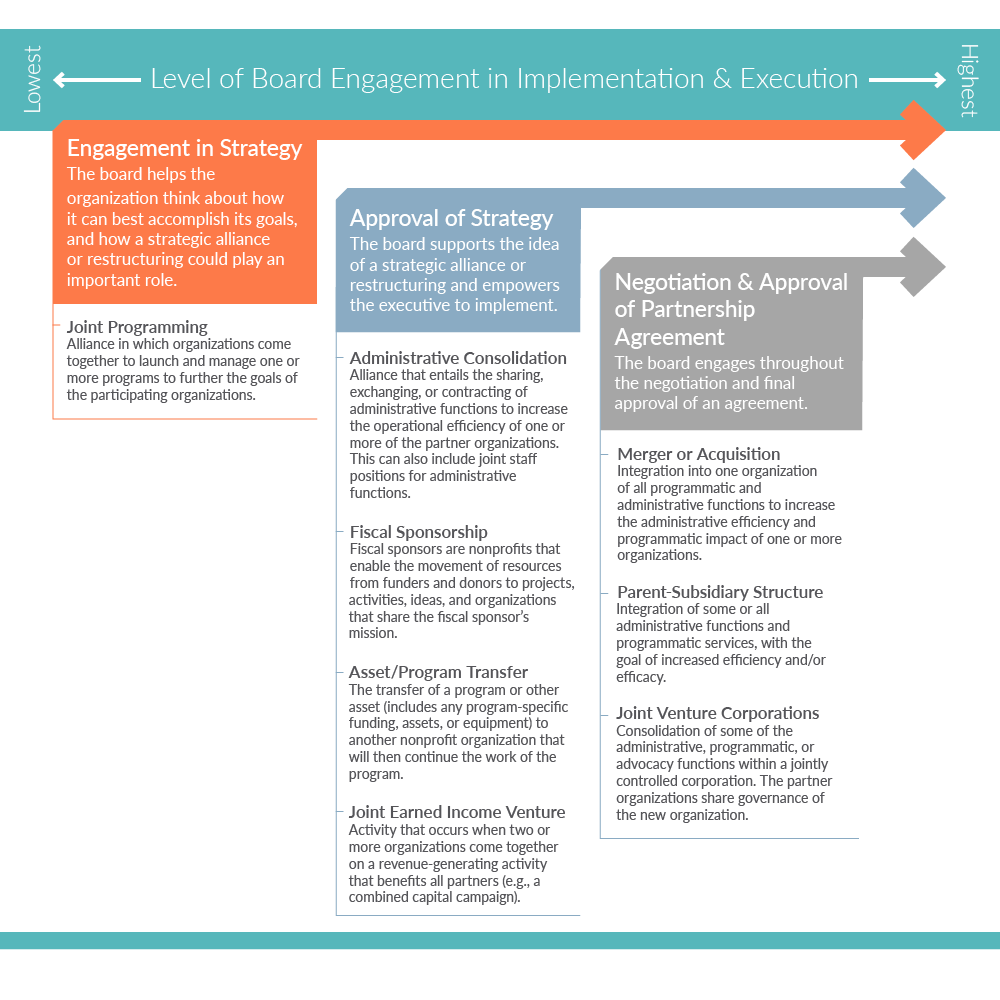What is the board’s role in strategic alliances and restructuring?
When it comes to strategic alliances and restructuring, boards can play a number of different roles. In general, they fall into the following categories:
Strategy & Planning
According to The Ten Basic Responsibilities of Nonprofit Boards, boards have a number of responsibilities related to strategy and planning, including the following:
- Determining mission & purposes (and advocating for them)
- Ensuring effective planning
- Monitoring and strengthening programs and services
- Ensuring adequate financial resources
- Enhancing the organization’s public standing
As the board fulfills these roles, they have an opportunity to help identify and surface when there might be an opportunity – or need – to think creatively about how a strategic alliance or restructuring could help the organization serve its core mission or purpose.
This type of board engagement typically takes place as a part of full-board conversation about strategy or as a part of focused planning and strategy that may be led by a board task force. For more on how boards can do this, see the discussion guide on strategy and planning.
Identifying & Connecting With Potential Partners
If the board has identified that a strategic alliance or restructuring could be an opportunity for the organization to expand its impact, board members can play an important role in helping to identify potential collaborative partners. Board members typically have strong networks and may be well-positioned to suggest organizations that are worthy of consideration.
Existing relationships and trust can be enormously helpful as organizations set the stage for a first conversation about a potential strategic alliance or restructuring, so it’s wise to consider how board members can be helpful. That said, board members should avoid initiating a conversation with a potential partner without being empowered to do so by the full board (in cases of mergers or acquisitions) or by the executive (in other programmatic partnerships).
Negotiating & Approving Strategic Alliances & Restructuring
Some types of strategic alliances and restructuring will require board engagement in negotiating and approving the agreement, whereas others do not require board involvement and should be handled by the executive or his or her staff team. Because it’s not always clear at the onset of conversations what form a particular strategic alliance or restructuring will take, board members should be prepared to become more or less engaged, depending on how the conversations proceed. For example, if a conversation begins as a discussion of a possible joint program, the board may be less involved. But if – as conversations continue – it becomes clear that both organizations would be strengthened by a merger, the two boards will need to become more involved.
The Spectrum of Board Engagement
It is easiest to understand strategic alliances and restructuring as a spectrum that ranges from less formal relationships to more structured partnerships to the full integration of two or more organizations, with the board playing an increased role as strategic partnerships become more structured and permanent. While organizations can (appropriately) have different levels of board engagement in programming depending on the lifecycle stage in which the organization is operating, the following are some general guidelines on how boards typically engage in different forms of strategic alliances and restructuring.
